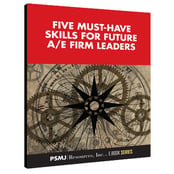
I discovered some fascinating research, the subject of an article in an issue of ARCHITECT, the journal of the American Institute of Architects. Amanda Kolson Hurley discusses research by Robert Gaarder, entitled "A Difficult Character", on a small but valid sample of 100 architects. Gaarder discovered that more than half of architects were either ENTJs (31%) or INTJs (20%) in the Myers-Briggs personality type scale. This compares to just 1.8% of ENTJs and 2.1% for INTJs in the entire population.
This means that about half of architects are Thinking rather than Feeling; Intuitive rather than Sensing, and Judging rather than Perceiving. And that, at least in the sample, 60% of them are Extroverts and 40% Introverts.
Architects' clients (the general population) are much more likely to be ISFJ (introvert-sensing-feeling-judging) – 13.8%; ESFJ (extrovert-sensing-feeling-judging) – 12.5%; or ISTJ (introvert-sensing-thinking-judging) – 11.6%. In the US population, these three types together make up about 38% of the population.
Although ENTJ architects have useful strengths, Hurley suggests they may also have disadvantages:
Another common drawback of the ENTJ type is a go-it-alone attitude—a lack of empathy and an impatience with teamwork. 'There’s an arrogance about an ENTJ, often,' Gaarder observes. 'It’s like, "Well, I know what’s best for this client." Collaborative practice and team-based 'design thinking' may be all the rage in the profession right now, but clearly, they don’t come naturally to a great many architects, who’d rather present their own ideas for others to implement without discussion.
"To make an enterprise truly collaborative, all architects—and ENTJs in particular—need to strive for self-awareness, so they can understand their limitations as well as their talents. 'What do I do in groups? Am I listening? Am I really open?' are a few of the questions that Gaarder suggests they ask themselves. In his leadership training sessions, he does an exercise in which participants plan a project, first by themselves and then as a team. “It takes three times as long to do it as a team, but they get a better product,” he notes.
 To learn more about the path to firm leadership, check out PSMJ's complimentary ebook Five Must-Have Skills for Future A/E Firm Leaders. Whether you are trying to become a leader in your firm or are an employer looking to develop leaders for your firm's future success, you will find simple, yet effective leadership development strategies in this e-book.
To learn more about the path to firm leadership, check out PSMJ's complimentary ebook Five Must-Have Skills for Future A/E Firm Leaders. Whether you are trying to become a leader in your firm or are an employer looking to develop leaders for your firm's future success, you will find simple, yet effective leadership development strategies in this e-book.
Other leadership development-related blog posts:
Where Are The Next Generation Leaders?
Expert Interview: Advice on Coaching and Mentoring
Developing the Next Generation of Principals
From PSMJ's A/E Industry Summit: Leadership Lessons From Shackleton


